Seismic response of a mid-story isolated structure considering SSI in mountainous areas under long-period earthquakes
Wan Feng, Qin Shengwu, Liu Dewen, Zhao Tiange, Zheng Yanping, Shan Hang, Li Zhiang,Peng Fusong, Xu Jingran and Lei Min
1.College of Construction Engineering, Jilin University, Changchun 130015, China
2.College of Civil Engineering, Southwest Forestry University, Kunming 650024, China
3.College of civil engineering, Southwest Jiaotong University, Chengdu 610031, China
Abstract: At present, there is not much research on mid-story isolated structures in mountainous areas.In this study,a model of a mid-story isolated structure considering soil-structure interaction (SSI) in mountainous areas is established along with a model that does not consider SSI.Eight long-period earthquake waves and two ordinary earthquake waves are selected as inputs for the dynamic time history analysis of the structure.The results show that the seismic response of a midstory isolated structure considering SSI in mountainous areas can be amplified when compared with a structure that does not consider SSI.The structure response under long-period earthquakes is larger than that of ordinary earthquakes.The structure response under far-field harmonic-like earthquakes is larger than that of near-fault pulse-type earthquakes.The structure response under near-fault pulse-type earthquakes is larger than that of far-field non-harmonic earthquakes.When subjected to long-period earthquakes, the displacement of the isolated bearings exceeded the limit value, which led to instability and overturning of the structure.The structure with dampers in the isolated story could adequately control the nonlinear response of the structure, effectively reduce the displacement of the isolated bearings, and provide a convenient, efficient and economic method not only for new construction but also to retrofit existing structures.
Keywords: SSI in mountainous areas; long-period earthquakes; mid-story isolated structure; structural dynamic analysis
1 Introduction
Mid-story isolated structures are a new type of isolation system which has been developed from base isolated systems.Liet al.(2015) discussed the issues that need to be further analyzed in the study of mid-story isolated structures, and described the current situation and development of mid-story isolation technology.Liet al.(2019) analyzed a high-rise building structures under earthquakes, and found that the mid-story isolated structure had a good damping effect.Shoheiet al.(2018) proposed a real-time hybrid simulation method to simulate a mid-story isolated structure.Kimet al.(2016) verified the isolated effect by analyzing the seismic response of a dome structure with a mid-story isolated structure.Al-Ghazali and Shariatmadar (2021)studied viscous dampers (VDs) connected to multistory buildings.Liuet al.(2022) evaluated the damage index of a high-rise frame-core tube structure under multi-dimensional random earthquakes.Tsipianitis and Tsompanakis (2022) integrated different grades of linear viscous dampers into isolated tanks of single-friction pendulum devices to study their seismic performance effects.
The soil-structure interaction (SSI) is a popular research topic on the impact of earthquakes.Rajkumaret al.(2021) studied the influence of SSI by considering the properties of soft soil.Rama Raoet al.(2021) used the finite element software SAP2000 to analyze hard,medium and soft soil conditions, and used pushover method analysis to study the seismic response of ground buildings.Linet al.(2021) proposed a new SSI calculation model that can accurately and efficiently calculate for complex foundation.Gharad and Sonparote(2021) considered 3D bridge finite element analysis under three different soil conditions to determine their impact factor values.This research has proven the importance of SSI analysis.
Buildings in mountainous areas are very complex.At present, there are few studies on mid-story isolated structures considering SSI under earthquakes.Liu and Yang (2016) discussed that due to the large slope of mountainous terrain, it was necessary to fully consider the stability and earthquakes resistance of buildings in these areas.Xuet al.(2017) carried out elastoplastic analysis and vulnerability analysis of different types of frame structure under earthquakes, and compared the effect of failure modes and improvement measures of each structure.Wuet al.(2014) verified the accuracy of the finite element model to simulate the stress response of split-foundation frame structures by analyzing the failure mode of a five-story and three-cross mountain model in a quasi-static test.Earthquake collapse vulnerability analysis was carried out for the calculation examples, the earthquake collapse resistance capacity of each example was quantitatively evaluated, and the relationship between the failure mode and earthquake collapse resistance capacity was analyzed.
In the Wenchuan earthquakes of 2008, high-rise buildings in Xi’an and Lanzhou, several hundred kilometers away from the epicenter, were damaged in various ways, and many long-period earthquakes were detected.The current code in China is mainly based on ordinary earthquakes and does not fully consider the influence of long-period earthquakes.Yanet al.(2019) defined the characteristics of far-field longperiod earthquakes.The high-frequency components of earthquakes attenuated with the propagation distance and the low-frequency components were amplified due to site factors, which were mainly composed of long-duration surface waves.Far-field long-period earthquakes have the characteristics of long-duration and abundant lowfrequency components.Liet al.(2014) usedPGV/PGAto evaluate the pulse characteristics of earthquakes and defined the parameterβ1to distinguish the longperiod earthquakes.Whenβ1>0.4, the proportion of low-frequency earthquakes is larger, and they are defined as long-period earthquakes; whenβ1<0.2, the proportion of medium-high frequency earthquakes is larger, and they are defined as ordinary earthquakes;events in between them are defined as medium-longperiod earthquakes.Zhang and Yu (2019) summarized the definition and classification methods of near-fault and far-field long-period earthquakes, and proposed a more reliable definition method that combined the epicenter distance and parameterT0.9.Wuet al.(2017)and Yanet al.(2018) found that the isolated effect under long-period events was poor, and far-field long-period harmonic-like earthquakes had an amplification effect on the isolated structure.Chenget al.(2021) studied the energy response of a single degree of freedom system under the action of two types of long-period earthquakes by using elastoplastic dynamic analysis.It provided a basis for the earthquake resistance of structures under long-period earthquakes.Wanget al.(2021) proposed a new response control mechanism of MSCSS to study the response control effect under long-period earthquakes.The results showed that MSCSS has good energy dissipation effect under long-period earthquakes.Xuet al.(2022) introduced the concept of floor torsion angle to define the torsional effect caused by long-period earthquakes.Zenget al.(2018) found that the damping effect of an isolated structure system with SSI became worse under long-period earthquakes.
There is currently a lack of knowledge on the seismic response of mid-story isolated structures considering SSI in mountainous areas under long-period earthquakes.To address this issue, two models of a mid-story isolated structure in a mountainous area were established: one that considered SSI and the other that did not consider SSI.The seismic responses of the structure under farfield long-period, near-fault pulse-type and ordinary earthquakes were compared, and solutions were proposed.
2 Finite element model establishment
2.1 Project overview
A model of a 10-story frame structure was established,with a total height of 36.9 m and rectangular plane of 30 m × 18 m.The bottom story height was 4.5 m and the other story heights were 3.6 m.The designed earthquake acceleration was 0.20 g.The grade of beams, columns and plates was C40 and the grade of the foundation was C30.HRB400 was adopted in rebar and HPB300 was adopted for the stirrups.The details of the structure are shown in Table 1.
2.2 Mid-story isolated structure model considering SSI in mountainous areas
Finite element software was used to establish the model of a mid-story isolated structure considering SSI in mountainous areas.Meanwhile, the model of a mid-story isolated structure without considering SSI was established, as shown in Fig.1.The frame in Fig.1 was simulated by a beam element, while the floor was simulated by a shell element.Among them, the Takeda hysteretic model was adopted in concrete units while the kinematic hysteretic model was adopted in the rebar.The soil in Fig.1 was simulated by a solid element and thesize of foundation soil was taken as 300 m × 180 m ×30 m, which was 10 times the size of the structure.The density of the foundation soil was 2100 kg/m3, with a shear modulus of 4.69×108N/m2and volume modulus of 1.1 8× 109N/m2.The soil was connected to rigid bedrock at the bottom and was simulated by fixed hinge bearings.The soil was connected to the bottom of the structure with a thickness of 1.5 m.The SAP2000 damper unit was used to simulate the viscoelastic artificial boundary to absorb earthquakes at the soil edge (Wolf, 1986; Liu and Lv, 1998; Liuet al., 2005, 2006; Kouroussiset al., 2011; Givoli, 2004; Haideret al., 2019).Isolated bearings were set at the bottom of the third column of the structure.LRB800 and LRB900 were used in the isolated bearings.The details of the parameters of the isolated bearings are shown in Table 2, and the layout of the isolated bearings is shown in Fig.2.
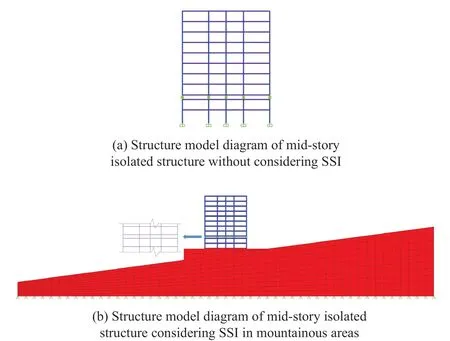
Fig.1 Model diagram
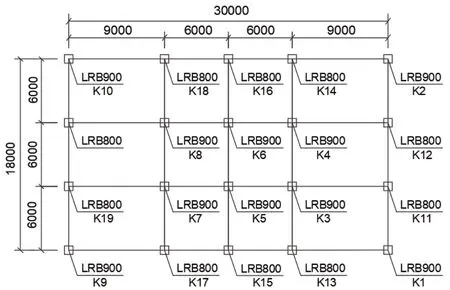
Fig.2 Layout of isolated bearings
2.3 Selection of long-period earthquakes
Long-period earthquakes have the characteristics of long duration and rich low-frequency components.Long-period earthquakes can be divided into near-fault long-period pulse-type earthquakes and far-field longperiod earthquakes.The near-fault long-period pulsetype earthquakes can be divided into near-fault forward directivity and near-fault slip thrust type earthquakes,and the far-field long-period earthquakes can be divided into harmonic-like and non-harmonic earthquakes.
There are many discriminant methods for long-periods earthquakes.On the one hand, they can be evaluated through quantitative calculation.For example, the HHT method is used as a judgment indicator orPGV/PGA> 0.2 can be used as another important indicator.However,these two methods are not particularly accurate.Later,scholars put forward a more accurate definition method by combining epicentral distance and the parameterT0.9(Zhang and Yu, 2019).Using the HHT method, the normalized coefficient of 90% energy accumulation,T0.9, is obtained by dividing the Hilbert energy spectrum of the long periodic component from 5% to 95% energy duration by earthquakes duration.On the other hand, qualitative judgement can be made through observation.The peak value of the acceleration response spectrum of ordinary earthquakes mainly appears at 0.3-0.4 s, and the acceleration response spectrum begins to decay at about 0.7 s.The peak value of the acceleration response spectrum of far-field long-period non-harmonic earthquake waves acceleration response spectrum is between 0.9 s and 1.2 s.The acceleration response spectrum of far-field long-period harmoniclike earthquakes is obviously larger than that of ordinary earthquakes, and earthquake waves will appear as a“double peak” phenomenon at 4-6 s.
In this study, eight long-period earthquake waves were selected, which were mainly based on the formula from Liet al.(2014) to define long-period earthquakes,
whereTiis the uniformly spaced discrete period of the acceleration response spectrum when the damping ratio is 5%, the value range is [2,10].Sa(Ti) is the spectral value of the acceleration response corresponding toTi,andPGAis the peak acceleration.

Table 2 Isolated bearings parameters
In this study, ten earthquake waves were selected from the website of the Pacific Earthquake Engineering Research Center according to the definition formula of long-period earthquakes, epicentral distance and parameterT0.9.Among them, there were three far-field long-period harmonic-like earthquake waves, three farfield long-period non-harmonic earthquake waves, two near-fault long-period pulse-type earthquake waves and two ordinary earthquake waves.The information of the earthquake waves is shown in Table 3.Earthquake waves in theXandYdirections were input to the structure separately.The peak value of acceleration was adjusted to 400 cm/s2and the elastoplastic time history analysis under the earthquakes was carried out.
2.4 Analysis of earthquake waves characteristics
Figure 3 shows the acceleration response spectrum curves of different earthquake types.Figure 4 shows the acceleration time history curves of each earthquake.It can be seen from the figures that the long-period earthquakes have the characteristics of long duration,rich low-frequency components and large time history acceleration peak.
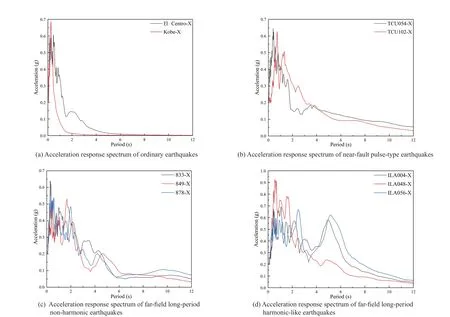
Fig.3 Acceleration response spectrum of different types of earthquakes
3 Seismic response analysis of mid-story isolated structure
3.1 Structural shear force comparison
Earthquake waves in theXandYdirections were input to the structure separately, and the comparison of base shear force of the mid-story isolated structure considering SSI in mountainous areas and the structure without considering SSI is shown in Fig.5.The interstory shear force comparison is shown in Fig.6.It can be seen from the figure that the response of the inter-story shear force and base shear force of the mid-story isolated structure considering SSI in mountainous areas is greater than that of the structure without considering SSI under long-period earthquakes and ordinary earthquakes.
3.2 Inter-story displacement comparison
Figure 7 shows the displacement of the interstory comparison of the mid-story isolated structure considering SSI in mountainous areas and the structure without considering SSI.It can be seen from the figure that the seismic response of the mid-story isolated structure considering SSI in mountainous areas is greaterthan that of the structure without considering SSI.Under long-period earthquakes, the seismic response of the midstory isolated structure considering SSI in mountainous areas is larger than that of ordinary earthquakes.The law of structure response under earthquakes is: far-field long-period earthquakes > near-fault long-period pulsetype earthquakes > ordinary earthquakes.
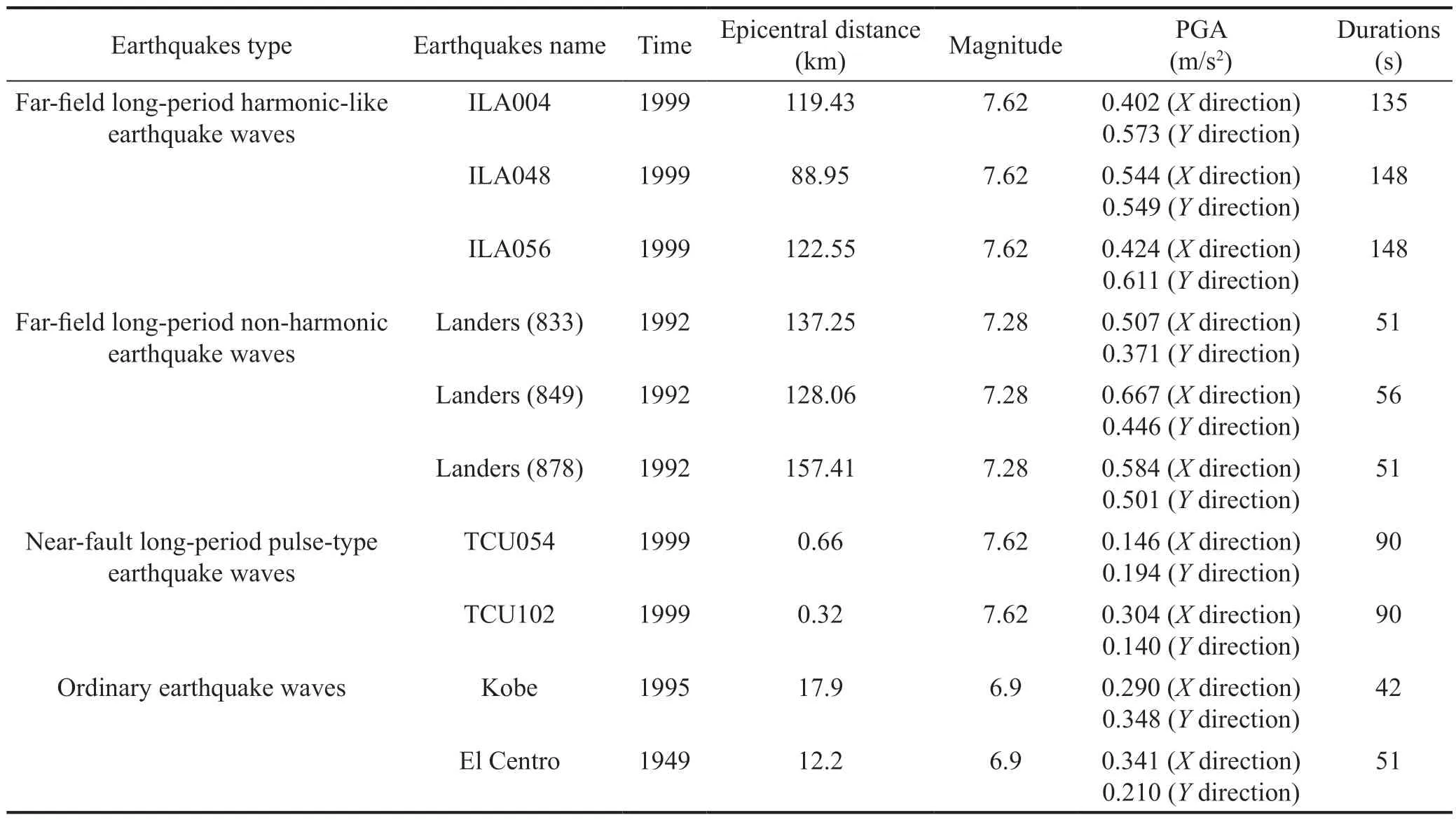
Table 3 Earthquake parameters
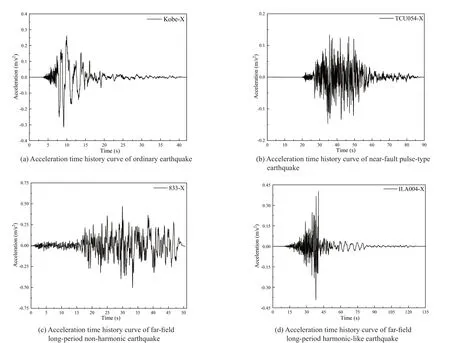
Fig.4 Acceleration time history curves of different types of earthquakes

Fig.6 Inter-story shear force of mid-story isolated structure

Fig.7 Inter-story displacement of mid-story isolated structure
According to the Code for Seismic Design of Buildings (GB 50011-2010, 2010), the maximum horizontal displacement of isolated bearings under earthquakes should not exceed the smaller value between 0.55 times the bearings diameter and three times the bearings total rubber thickness.Because the isolated bearings are LRB800 and LRB900 in this study, the limit value should be:
The maximum displacement of the isolated story of the structure considering SSI in mountainous areas and without considering SSI are shown in Tables 4 and 5.It can be seen from Table 4 that the displacements of the isolated story under far-field long-period harmonic-like earthquake wave ILA056 are 767.26 mm and 781.69 mm in theXandYdirections.The displacements of isolated story under the near-fault long-period pulse-type earthquake wave TCU102 are 449.69 mm and 515.29 mm in theXandYdirections, and all exceed the requirements of the limit value.The displacement of the isolated story under far-field long period non-harmonic earthquake wave Landers (878) is 400.59 mm in theXdirection, which is close to the limit value.It can be seen from Table 5 that the maximum displacement of the isolated story of the mid-story isolated structure considering SSI in mountainous areas is greater than that of the structure without considering SSI.The results show that the mid-story isolated structure cannot meet the requirements under long-period earthquakes.
In summary, whether considering SSI or not,long-period earthquakes will have adverse effects on the structure.Compared with ordinary earthquakes,structure response under long-period earthquakes will be amplified.Therefore, the influence of long-period earthquakes should be considered in structural design.
4 Seismic response of mid-story isolated structure with dampers
4.1 Modeling of mid-story isolated structure with dampers
Since the isolated bearings did not meet the requirements under long-period earthquakes, an improved scheme with dampers was proposed.Keeping the original structure unchanged, the dampers were crossconnected in the isolated story, and the two ends of the dampers were connected with the upper and lower beam ends.Fourteen dampers were arranged symmetrically around the periphery of the isolated story, as shown in Fig.8.The damper-exponential element in SAP2000 was used to simulate the dampers, the coefficient of the dampers was 2000 kN.s/m, and the damping exponent was 0.3 (Stefano and Terenzi, 2012; Mazza, 2016).The seismic response of the mid-story isolated structure with dampers was then analyzed.
4.2 Structural periods analysis
The modal analysis of the mid-story isolated structure with dampers and without dampers is carried out.The first six structural periods are shown in Table 6.It can be seen from Table 6 that the first six structural periods of the mid-story isolated structure with dampers are slightly smaller than those of the mid-story isolated structure without dampers, and the stiffness of the structure with dampers is slightly contributed.
4.3 Isolated effect analysis
4.3.1 Displacement comparison
Figure 9 shows a comparison of the maximum displacement of the isolated story.Figure 10 shows the displacement of the inter-story.
It can be seen from Fig.9 that the displacement of the isolated story with dampers is greatly reduced.The displacements of the isolated story under the far-field long-period harmonic-like earthquake wave ILA056 are 402.74 mm and 212.51 mm in theXandYdirections.The displacements of the isolated story under the nearfield long-period pulse-type earthquake wave TCU102 are 287.70 mm and 151.16 mm in theXandYdirections,and all meet the requirements of the limit value.In comparison, the displacements of the isolated story under the far-field long-period harmonic-like earthquakewave ILA056 are 767.26 mm and 781.69 mm in theXandYdirections.The displacements of the isolated story under the near-fault long-period pulse-type earthquake wave TCU102 are 449.69 mm and 515.29 mm in theXandYdirections, indicating that the mid-story isolated structure with dampers can reduce the displacement of the isolated story and ensure the safety of the structure.

Table 4 Maximum displacement of isolated story considering SSI in mountainous areas

Table 5 Maximum displacement of isolated story without considering SSI
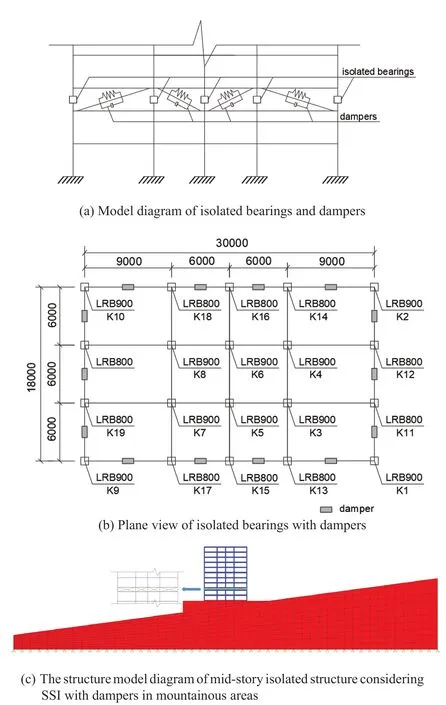
Fig.8 Details of the mid-story isolated structure with dampers

Fig.9 Maximum displacement of isolated story comparison

Table 6 First six periods of the structures
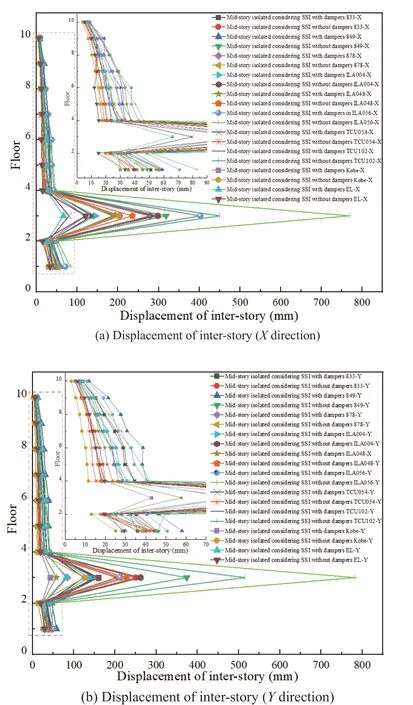
Fig.10 Inter-story displacement of mid-story isolated structure
It can be seen from Fig.10 that the displacement of the inter-story increases slightly, and the displacement of the inter-story drift angles do not exceed the limit value,which is within the safe range.
In summary, when the structure encounters longperiod earthquakes, the displacement of the isolated story can easily exceed the limit value.The mid-story isolated structure with dampers will reduce the displacement of the isolated story to ensure the safety of the structure.Since it is difficult to replace the isolated bearings, it provides a convenient, efficient and economic method not only for structures to be built but also for reinforcement of existing structures.
4.3.2 Isolated bearings stress comparison
The stress of the isolated bearings is also an important index of the structure.Figure 11 shows the stress diagram of the isolated bearings.
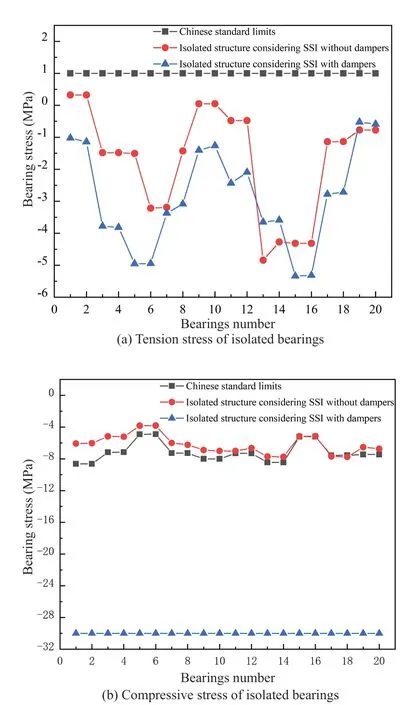
Fig.11 Stress of isolated bearings
The earthquake wave ILA056, which led to the largest structure response, is selected to check the stress of the isolated bearings.According to GB 50011-2010(2010), the compressive stress of the isolated bearing is twice the fundamental pressure, and the compressive stress limit value is 30 MPa.The earthquake isolated bearings should not appear to have tension stress; when a few bearings exhibit tension stress, their limit value should not exceed 1 MPa.
Overturning failure occurs when tensile stress of the isolated bearings exceed 1 MPa, and collapse failure occurs when the compressive stress exceeds 30 MPa.It can be seen from Fig.11 that whether the dampers are added or not, the isolated bearings will not suffer from tension and compressive failure.The tension and compressive stresses of the mid-story isolated structure without dampers in mountainous areas is generally greater than that of the mid-story isolated structure with dampers.This shows that the tension and compression stress of the isolated bearings can be reduced by the dampers.
4.4 Structure damage comparison

Fig.12 Stress of different mid-story isolated structure
The stress of the mid-story isolated structure with dampers and without dampers is shown in Fig.12.It can be seen from the figure that the stress of the midstory isolated structure considering SSI with dampers in mountainous areas is slightly reduced when compared with that of the mid-story isolated structure without dampers.
4.5 Foundation stress comparison
The mid-story isolated structure with dampers has an excellent damping effect, however, the soil stress is also an important evaluation index.Figure 13 shows the soil stress of different mid-story isolated structures.It can be seen from the figure that the soil stress of the mid-story isolated structure with mid-story isolated dampers in mountainous areas is slightly larger than that of the midstory isolated structure without dampers.
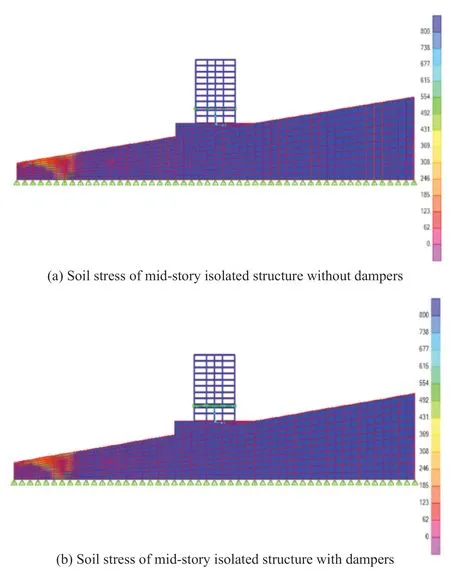
Fig.13 Soil stress of different types of mid-story isolated structure
5 Conclusions
In this study, finite element software is used to establish two mid-story isolated structure models in mountainous areas: one that considers SSI and one that did not.An elastoplastic time history analysis under earthquakes is carried out to obtain the seismic response.The conclusions are as follows:
(1) The seismic response of the mid-story isolated structure considering SSI in mountainous areas can be amplified when compared to the structure that does not consider SSI.
(2) The structure response under long-period earthquakes is larger than that of ordinary earthquakes.The structure response under far-field harmonic-like earthquakes is larger than that of near-fault pulse-type earthquakes.The structure response under near-fault pulse-type earthquakes is larger than that of far-field non-harmonic earthquakes.
(3) When subjected to long-period earthquakes,the isolated story is prone to over deformation and the displacement of the isolated bearings is larger than their limit value, which leads to instability and overturning of the structure.
(4) The mid-story isolated structure with dampers in the isolated story can adequately control its nonlinear response to earthquakes, effectively reducing the displacement of the isolated bearings, preventing the destruction of isolated bearings, and providing a convenient, efficient and economic method not only for new structures but also for the retrofit of existing structures.
Acknowledgment
The authors gratefully acknowledge the financial support from the National Natural Science Fund of China (Nos.52168072 and 51808467), and the Highlevel Talents Support Plan of Yunnan Province of China(2020).
 Earthquake Engineering and Engineering Vibration2024年1期
Earthquake Engineering and Engineering Vibration2024年1期
- Earthquake Engineering and Engineering Vibration的其它文章
- Reliability-based life-cycle cost seismic design optimization of coastal bridge piers with nonuniform corrosion using different materials
- Finite element model updating for structural damage detection using transmissibility data
- Experimental study on seismic reinforcement of bridge foundation on silty clay landslide with inclined interlayer
- A novel mitigation measure for normal fault-induced deformations on pile-raft systems
- Longitudinal vibration characteristics of a tapered pipe pile considering the vertical support of surrounding soil and construction disturbance
- Resilient performance of self-centering hybrid rocking walls with curved interface under pseudo-static loading
